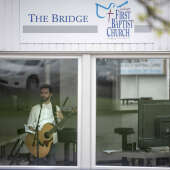Interior Design: Designing a model office space

Look around your office.
Now, depending on your industry -- and frankly, your position on the proverbial ladder -- the office you see could look quite a few different ways. Is your nearest wall a wall or a cubicle divider? Are there no walls at all? Can you hear the person nearest you? Do you really love "collaborative proximity," or is the truth that you'd probably get more done if people would just leave you alone to focus?
In any case, the important question is: To what degree does your current workspace facilitate the completion of today's to-dos?

The key to productivity, according to Rust & Martin Interior Designers' Mike Rust, is a workspace appropriately tailored to the work being done.
And that doesn't necessarily mean jumping on the latest trend. Exposed brick and communal desks, while great for Buzzfeed, could spell disaster for a regional CPA office. Turns out, Rust explains, trends are for megaliths.
"High-end corporations -- we're talking Apple, Coca-Cola -- they re-do their front offices every five years or so. It's something they build into the budget. In Cape Girardeau, we're not going to do that; businesses are more locally-focused. So let's get a design you're not going to have to change in five years," he says. "If the space isn't going to change much in the next 20 years, like a lawyer's office, why not invest in the next 20 years? Make it something that, if you walked into it 15 years ago or 15 years from now, you won't know when it was designed."

The most important part of a redesign, he says, is having a definite vision based on a clear-eyed assessment of the needs of the business. In short, it means talking to employees before breaking out the power tools. Because whatever the new conventional wisdom says about the best way to work, Rust says it's likely already been tried.
"There isn't anything really new, but it always changes," he says. "Open offices, fluid spaces, nobody having a designated space; that's pretty popular now, but it's happened many, many times before."
The 1970s saw the last wave of open-concept optimism, he says.

"But how productive can you be when you're sitting at a bar and talking to people?" Rust says. "The accounting apartment needs to sit down and get some work done."
But that doesn't mean everything trendy is hogwash, necessarily. Angela Francis, whose interior design business shares a space with her husband Rocky's industrial steel design business, says her husband's employees all prefer standing-height desks. Some intermittently use tall stools, but most prefer to stand.
And offices are more than just workspaces, Francis says.

"What's changing most is the environment [of the office]. The break room, for instance: it's not just a refrigerator and a microwave anymore," she says. "A lot of businesses want it to be personalized to an extent to make work a happier place, instead of just a utilitarian place."
Few offices in the region embody the "more than a workspace" ethos as much as business incubator Codefi, in the heart of the Marquette Tech District in downtown Cape Girardeau. More than 70 office spaces fill Codefi's three floors of the Marquette Tower, housing even more businesses. Fluid common areas and conference rooms allow teams to mingle with others or section themselves off for private work.
"The whole premise was that we wanted a place where people are attracted to come and work together and feel inspired," says co-founder Heather Holdman.
Located in the center is a bright orange kitchen, complete with plenty of coffee and even a few beer taps.
"It's a place to interact. You could be standing there talking to the founder of Lids, for instance, and if you're a startup owner, you wouldn't believe how often a casual conversation like that could lead to so much more," Holdman says.
Incorporating color and lots of natural light, she says, is important not only to help spark creativity in workers, but also to provide an attractive ambiance for businesses hosting clients.
"You can't be as inspired in a white-walls cubicle. And if you bring someone in, you want them to be impressed," she says.
Additionally, workplace technology is proving to be less of a trend and more of an evolution. We have cloud storage and mobile email now, and we're not going back. But some people, like co-owner of HD Media Systems Scott Starzinger, are leveraging technology to help maximize efficiency.
"There's been a big rush to do more conference rooms with updated technology," he says. "People want a huddle space where they can do Skype or phone conferencing, where you can exchange information and don't have to have the client come in for it."
The most popular systems, he says, allow screen sharing with more improved collaborative options than what traditional presentation systems like PowerPoint could provide.
"Let's say I have information to present on our budget and another person has numbers on how much we spent last year. I can have my information up on the screen and he can have his up on the other half so we don't have to jump back and forth. And the CEO doesn't have to even be in the room; he can just tap in, see the multi-view and make suggestions on the fly," Starzinger says.
And Starzinger says many of his clients are also looking to technology to solve problems posed by many traditional -- read, cubicle-based -- office layouts.
"We do a lot of white noise generation," he says. "There are little speakers we can install now that sound, really, like air blowing at a particular frequency that kills other noise and doesn't distract."
Not only can white-noise generators eliminate distracting crosstalk, it can also come in handy in environments like doctors' offices, where accidental eavesdropping could constitute a HIPPA violation.
"It's hospital board rooms, but it's also banks. It's just becoming more and more common," he says. "Nobody wants everybody and their brother to know their business."
Angela Francis says the best redesigns happen with a latitude of flexibility.
"Not in every situation can you get every demand on the wish list," she says. "But you certainly try. And managers like to think they have a good grasp on how people operate, but the best managers just have the conversations with people."
In short, the local expert consensus says it's usually better to ignore the trend pendulum in favor of an honest chat with the people who will be working in the office post-renovation.
Now put this article down and get back to work before the person in the next cubicle notices you slacking.
The Modern Office
Engage the best and brightest with a rad workplace
The workforce is changing, and office design is rising to meet the needs, demands and, yes, even wants of a younger workforce and a workplace forever altered by technology. The days of a steady 9 to 5 at the office are passing away as technology erases the need to be in the same room with people, allowing employees to take their work with them wherever they need or want to be. How can your business provide flexibility? The following trends and ideas to retain the brightest talent have been excerpted from the HOK article "Top 10 Trends Influencing Workplace Design."
1. Top talent is shrinking.
Our workforce is aging, and the labor force is expected to grow only 0.6 percent between 2016 and 2026. Skills predicted to be in demand include health care -- representing 16 of the 30 fastest-growing occupations -- management, legal, sales/marketing, operations and technical computer proficiency. This talent shortage will challenge organizations to find and keep the best people. Creating vibrant offices is one tactic to recruit and retain talent. Providing flexibility and choices for where, when and how work happens is also critical for attracting the best and brightest people.
2. Employee engagement matters.
Engaged employees can boost a company's bottom line; companies with disengaged employees experience 30 to 50 percent more turnover. The workplace can engage employees by acting as a communication tool that aids in celebrating individual or team contributions, broadcasting organizational goals or objectives, and providing spaces for effective collaboration. Involving employees in the design or retrofit of a workplace also provides a wonderful opportunity for engagement.
3. More people are working remotely and not at their desks.
At any given time, about one-third of all knowledge workers are working in airplanes, hotels, at client sites and at home. They need to be supported with technology and business processes that allow them to work effectively wherever they are. In the workplace, mobility may require more "unassigned" or touchdown space for individuals who are out of the office for a significant portion of the day.
4. Flexible work boosts engagement and satisfaction.
Flexible work -- allowing employees to work when, how and where they choose -- generally receives a positive response. Thirty percent of employees with easy access to flexible work arrangements report feeling very engaged in their jobs. Compare this to the 19 percent engagement among those with moderate flexibility and the 10 percent engagement among those with little access to flexibility. Sixty percent of employees with high access to flexibility are very satisfied with their jobs, compared with 44 percent of those with moderate access and only 22 percent of those with low access.
5. Activity-based work settings are on the rise.
Because the nature of today's work is so complex and unpredictable, a single, all-purpose workstation doesn't cut it for most knowledge workers. Workplace designers need to provide a variety of "activity settings," or purpose-built areas for specific activities accessible to all. Activity settings might include impromptu meeting areas, formal meeting spaces, project rooms, individual work spaces or break areas that make up for the shortcomings of exclusively cellular or open-plan environments. One size does not fit all.
6. Buildings can help or hinder productivity.
Buildings can improve overall productivity and performance by as much as 12.5 percent or reduce them by as much as 17 percent. Interestingly, the same factors that enable productivity can inhibit it. Some background noise, for example, can boost productivity for routine or administrative tasks. Yet that same noise can be highly distracting when employees are conducting research or writing tasks. Lighting is generally viewed as positive, except when it causes glare. That said, the most common building-related culprits for hindering productivity include issues with thermal comfort or air quality, lack of natural light, noise, spaces that feel crowded and poor ergonomics.
7. Lighting matters.
Better workplace lighting -- both natural daylight and artificial light -- has been linked to a 15 percent reduction in absenteeism in office environments.
8. Acoustics are vital.
Office acoustics contribute to performance and well-being in the workplace. To support complex knowledge work, many people seek out quiet places. The ability to have planned or spontaneous interactions without disturbing others is important for teamwork and relationship development. In environments with white noise, or sound masking, employees report improvements of up to 38 percent for the performance of simple tasks and 27 percent for complex tasks. Office layout, flooring materials, walls, ceilings and behavioral protocols also make a difference.
9. People are the most important metric.
A 2 to 5 percent increase in staff performance can cover the total cost of providing for their workplace accommodation. Financial losses due to absenteeism and "presenteeism" (a loss of workplace productivity from employee health problems or personal issues) account for 4 percent of operating costs.
10. Change management works.
Benchmarking studies have found that workplace projects with an effective change management component are six times more likely to meet their objectives and succeed. If you were given a new piece of software with no instructions on how to use it, would you be able to get the best out of your investment? Probably not. The same goes for a new workplace. When employees are experiencing new furniture, adjusting to a renovated office or moving into a different building, they need help learning how their new "tool" is supposed to work. The better they understand their space, the technologies that support it and the policies and protocols for how to use and behave in it, the more likely they are to get the most out of their work experience.

































